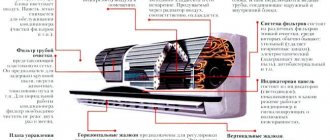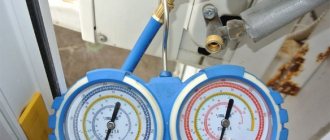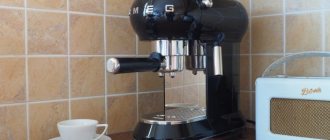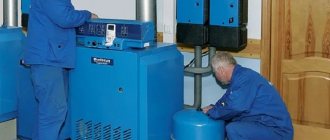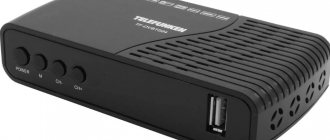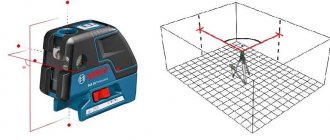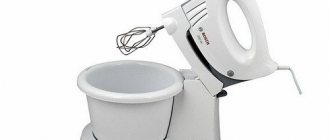How does an air conditioner work?
The system operates on a closed cycle principle. The air in the room is cooled by passing through the heat exchanger of the indoor unit, in which the refrigerant evaporates. Let's look at the operation of the device step by step.
- The compressor installed in the outdoor unit compresses the refrigerant and pumps it into the condenser in a gaseous state from the evaporator of the indoor unit.
- In the condenser, the freon is cooled due to heat exchange with the outside air and condenses. All this happens in the heat exchanger of the external unit.
- Next, the refrigerant passes through a throttling device, where a sharp decrease in freon pressure and temperature occurs. In this case, part of the liquid refrigerant inevitably turns into a gaseous state.
- Cold freon enters the heat exchanger of the indoor unit (evaporator), where, due to heat exchange with the air from the room, it boils and passes from a liquid to a gaseous state. The air, in turn, is cooled and enters the room.
Due to the way the air conditioner operates, drops of water—condensation—form on the evaporator. Typically, when installing a system, a separate pipe is installed to drain condensate. It goes outside or into the sewer so that there is no excess moisture in the room.
The direction of the exhaust air from the indoor unit is adjusted using a special curtain and blinds horizontally and vertically.
Operating principle and circuit diagram of the air conditioner
The air conditioner seems to be a fairly simple piece of equipment, the main structural components of which are not particularly complicated. Therefore, we will analyze in detail its operating principle, which is also extremely simple.
How does a typical air conditioner work?
As liquids evaporate, they absorb heat, actively, and during condensation (transition from a gaseous state back to a liquid) they release it. And these physical phenomena are traditionally the basis of the operating principle of air conditioners.
You can make sure that the specified method of heat removal is effective even at home. For example, applying any alcohol-containing solution to the surface of your skin, which, quickly evaporating, leaves behind a feeling of cold. Since heat from the surface of the body is absorbed and removed to the side.
To put it simply, the basis for the operation of any modern air conditioner is the boiling (with heat absorption) and condensation (with heat release) procedures. During these processes, heat is absorbed/released according to the formulas shown on the graph. Where Q is the amount of heat, L is the specific heat of vaporization, and m denotes the mass of the substance
This is exactly what happens indoors. The reason is that the liquid refrigerant, having entered the indoor unit of the air conditioner, actively and in large quantities absorbs excess heat, and its temperature rises significantly.
As a result, it evaporates and moves to the outdoor unit (usually located outside the building). Where, under the influence of colder air, pumped in significant quantities by a fan, the reverse process occurs.
The photo shows an air conditioner evaporator. Which in appearance resembles a regular radiator. Actually, that’s how it is. Since the design of this element ensures the most efficient blowing of warm room air, from which the refrigerant absorbs heat, so the room becomes cooler
That is, condensation occurs, as a result of which the refrigerant becomes liquid again, and, accordingly, heat is released. And then a new cycle will follow, and so on ad infinitum.
Schematic diagram of the equipment operation
Regardless of the type, type and name of the air conditioner, the air cooling process is always the same. So after switching on, the refrigerant is supplied to the evaporator. Moreover, its pressure is 3-5 atmospheres, and the temperature is in the range of 10-20 °C.
Next, in a gaseous state, freon moves to the compressor. And then it compresses to 15-20 atmospheres. In addition, the refrigerant is heated to 70-90 °C.
The diagram, in a simplified form, shows the operating principle of any modern air conditioner. So the figure shows that the refrigerant cooled in the condenser enters the flow regulator (thermostatic valve). Where its pressure decreases, which allows the liquid to cool even more. And then the refrigerant is transported to the evaporator, where the main process takes place. That is, cooling the air while simultaneously heating the refrigerant
After which the gas is transported to the condenser, actively blown by a fan. As a result of exposure to injected air at a lower temperature, freon releases heat, which leads to its transition to a liquid state.
But still its temperature remains 10-20 °C higher than that of the surrounding air. This problem is solved when the liquid moves through the expansion valve. Where the refrigerant pressure drops again to a small 3-5 atmospheres. This allows the freon to cool further and is ready for a new cycle of heat absorption, so it is again supplied to the evaporator.
The figure shows a schematic diagram of an air conditioner. In this case, one unit equipped with an evaporator is located indoors. And the second one, with a capacitor, is outside. This allows you to make the heat exchange procedure as efficient as possible. In addition, the unit, which is located on the street, always houses a compressor, which is the noisiest part of the structure
Features of the air conditioner
An air conditioner requires electricity to operate, but this is beneficial because it has a fairly high efficiency.
But if there are regular voltage drops in the network, then in order to avoid breakdown of this type of climate control equipment, you should immediately install a stabilizer.
Despite the simple and effective method of heat exchange, you should always remember that the air conditioner will only meet its declared characteristics with regular maintenance.
How does an inverter air conditioner work?
The peculiarity of this device is that the compressor turns on once during the entire operation of the air conditioner and remains in this state constantly, changing the speed depending on the load on the air conditioner. In turn, a conventional air conditioner (on/off) periodically turns on and off without changing the speed. The inverter saves energy and extends the life of the compressor, since it works without turning on/off, but smoothly changing the number of revolutions.
An inverter model will be more economical than any other air conditioner if it runs for at least several hours without turning off.
The inverter model, like a conventional air conditioner, has two units - external and internal. The external one contains a compressor, copper freon pipelines, a fan and a condenser. The indoor unit consists of an evaporator, a fan, blinds, a filter and a special tray for the condensate formed.
How split systems work and their types
The split system consists of outdoor and indoor units. The outer one contains the compressor, control board, fan and capacitor. The main elements of the indoor unit: evaporator, fan, filters, temperature sensors and condensate tray.
Freon circulates in a closed circuit. It consists of:
- internal coil - evaporative heat exchanger;
- external coil – condenser heat exchanger;
- connecting copper pipes - freon line;
- compressor that increases pressure;
- capillary tube for household systems;
- thermostatic valve (TRV) for semi-industrial units.
The capillary tube and expansion valve have a common synonym - a throttling device. They provide a difference in pressure between condensation and boiling of the refrigerant due to hydraulic resistance along the entire length.
Air conditioners that can heat the air have a 4-way valve that functionally swaps two heat exchangers - the external one is responsible for the evaporation of the refrigerant, and the internal one is responsible for its condensation.
Cooling work
Freon enters the compressor, where its pressure increases 3 times, and the temperature rises by 50-60°C, that is, compression occurs. Then it goes into the condenser and is blown with colder air, after which it turns into a liquid state. The air passes through the condenser heat exchanger and is heated by the heat generated by the freon.
The refrigerant then moves into a spiral-shaped capillary tube, or expansion valve, where its pressure decreases, the temperature drops, and some evaporation occurs. The evaporative heat exchanger is purged with room air, but when colder freon enters, it cools down. The refrigerant then takes away its heat and returns to its original state. Then the cycle repeats.
When operating in cold conditions, the operation scheme of a split system air conditioner consists of 4 main stages: compression, condensation, rarefaction and evaporation.
Heating work
The essence of the operating principle of a split system air conditioner for heating does not change. When the 4-way valve switches the functions of the units, when the direction of the refrigerant flow changes, air is taken from the street by the outdoor unit, where freon evaporates, and it is delivered to the room by the indoor unit, in which the refrigerant again goes into the gaseous phase.
The lower the air temperature outside, the more difficult it is to extract heat from it, since the difference between the air temperature and the freon evaporation temperature decreases, therefore, the heating capacity decreases due to the equalization of their values.
Precision air conditioners
Precision climate control technology does not differ in operating principle from a split system, but has a number of features:
- Capable of operating 24/7/365 for 10 years, while a household split system will last no more than 2 years.
- It has a powerful fan, due to which the cooling quality is higher than that of a split. Air flows of a given temperature are evenly distributed throughout the room.
- The working substance can be freon, water or glycol.
- Air humidification is carried out using an electrode-type steam generator.
Precision air conditioners are used in server rooms, where it is necessary to continuously maintain a certain temperature and humidity.
Inverter air conditioners
The operating principle of an inverter air conditioner is the same as a conventional one. The difference between inverter-type climate control equipment lies in the control of the operating mode. In a conventional split system, when the set temperature is reached, the compressor turns off. When the temperature changes upward, the supercharger starts. Thus, the system operates at full capacity, but intermittently.
Inverter motors have a frequency converter board that changes the standard frequency of the electrical network. The fan does not stop working when the temperature norm is reached: it gradually slows down its rotation, and when the air heats up by 1 degree, it increases the number of revolutions per unit time.
The advantages of such control are the durability of the equipment and energy savings of up to 30% compared to non-inverter split systems.
Duct climate system
A system of inlet and outlet air ducts extends from the indoor unit of a ducted air conditioner, through which warm air is taken in and cold air is supplied to one or more rooms.
Equipment of this type has the function of introducing fresh air from the street up to 30%.
Installation of a duct-type air conditioner is best done at the construction stage of the building - the unit is installed under the ceiling along with the ventilation system.
Design and principle of operation of a split system
The usual classic split system consists of two modules (blocks) - external and internal. The design of the external unit of an on/off type split system is almost always the same.
External unit
The external unit includes a compressor, a condenser, a four-way valve, and also has a capillary tube.
All units contain a filter drier that cleans and dries the refrigerant from possible moisture entering the system and various types of contaminants. In inverter-type split systems, the external unit also contains a control board, which is also found in multi-split systems. Due to the fact that the compressor is located in the outdoor unit, the noise level from a working air conditioner in the apartment is much lower than from the street. The dimensions of the external unit may vary depending on the performance of the model, as well as the brand.
The indoor unit is connected to the external unit using freon pipelines. There is also a drainage line and an electrical cable to power the indoor and outdoor units.
The external unit of the air conditioner should always be located on the street side. It is attached to the outside of the wall. If the air conditioner needs to be installed at a sufficient height from the ground and it is not possible to mount the outdoor unit in the usual way, then climber installers with special gear and equipment are invited. Without such devices it is impossible to install the external unit high. Also, the outdoor unit can be installed on the roof of buildings, on unglazed balconies and loggias, open common balconies or flights of stairs with open access to the street. Often external blocks are supplied in a vandal-proof casing; if this is not provided by the manufacturer, then a block installed at the level of the first floors can additionally be placed in a special protective box made of metal rods. To prevent the accumulation of snow or rainwater, as well as debris, a special sloping canopy is sometimes installed over the external units.
Indoor unit
The internal units of a split system differ significantly from each other. Firstly, it depends on the manufacturer, i.e. all internal units differ in design, and secondly, the units differ in the type of installation, and, accordingly, have a significant difference not only in the design of the front panel, but also the housing as a whole. Also, indoor units, depending on the manufacturer, power and model, may differ in components, functionality, and overall dimensions.
Split system indoor units can be of the following types:
- wall-mounted – they are designed for installation on a wall;
- cassette - placed in the area of the ceiling space;
- duct - installed in the area of the ceiling space with an air duct system;
- floor-subceiling – can be installed both on the floor and in the area under the ceiling;
- columned - installed on the floor, they are large in size compared to other types of indoor units of classic split systems.
The operation of the indoor unit is regulated thanks to an electronic board. The indoor unit contains filters for air purification, automation, an evaporator and a fan for blowing the evaporator heat exchanger. The main functions of modern split systems are ventilation, dehumidification, cooling, heating and maintaining a given room temperature. Control using remote control. Almost all modern models of split systems are equipped with a remote control. With its help, you not only turn the device on and off, but also control all functions - setting the temperature mode, turning on the timer, programming tasks, turning on all modes provided for a specific air conditioner model. If the model has the “I feel” function, then thanks to the temperature sensor in the remote control, the air conditioner monitors the ambient air temperature in the room, and when the temperature set by the user is reached, the equipment maintains it. On the indoor unit, the direction of the air flow is adjusted by changing the angle of the blinds. The operation of the compressor of the external unit is regulated by constant monitoring of all systems.
Features of the functioning of floor air conditioners
These models are rarely used if a standard split cannot be installed. Floor-standing air conditioners are also only stationary. Stationary models have a similar operating principle as a conventional air conditioner, with the exception of the installation of an indoor unit. It is not located under the ceiling, but at a height of half a meter from the floor. The external unit is located on the street. Such split systems belong to the semi-industrial series. As a rule, they are more productive than household models.
Features of mobile models
The mobile model has only one unit and is located indoors. It contains a compressor, evaporator and condenser. The functioning mechanism is based on the processing of indoor air.
Usually it is not recommended to choose a mobile model, since the noisiest part will be installed not outside the window, but indoors. When the air conditioner is on, you will feel uncomfortable in the room. In addition, they are characterized by low power.
Air conditioning device
You can best understand the principle of operation of the system by familiarizing yourself with the individual components of the device. A split system consists of two components - internal and external, which cannot exist without each other and are interconnected.
External part of the air conditioner
The outdoor unit is installed on the street side and is designed to cool hot freon. It consists of the following elements:
- the fan creates air currents that blow across the condenser;
- Condenser - The cooling and conditioning component of the refrigerant. The air passing through it is heated and discharged outside;
- compressor - one of the main components of the system, responsible for compressing and circulating the coolant through the refrigeration circuits;
- the control unit can be located both in the external and internal parts of the device, depending on the model;
- four-code valve - a mechanism that allows switching between cooling and heating modes. With its help, the direction of freon and the operating principles of the indoor and outdoor units change;
- a coolant filter is located in front of the compressor to protect the housing from debris and dust getting into the system;
- various fitting connections - parts designed to connect copper pipes between the internal and external components;
- The protective panel provides reliable protection of the housing from damage and penetration.
External unit device
Indoor unit
Located indoors, its structure is in many ways similar to the design of the external one, but has its own design features:
- The front panel is made of reliable plastic and is designed to allow air flow into the room. It is easy to remove and reinstall to clean or replace filters;
- The coarse filter is a plastic mesh that can hold large debris, animal hair, etc. It needs to be cleaned every month;
- fine filters are a whole system of filter elements consisting of carbon, antibacterial, electrostatic and other cleaning units. Depending on the model of the unit, the kit may include only individual components or all at once;
- cooler - a fan that circulates air in the room, both cold and heated;
- evaporator - a mandatory element of the system, responsible for cooling the freon;
- blinds - an external component designed to regulate the direction of flow;
- panel with indicators - a small display that displays the operating mode of the device, possible error codes, on some models it also shows the current temperature and time;
- control board - the part houses the electronic unit and central processor.
Design of the indoor unit of the air conditioner
Interesting! Most often, air conditioning equipment operates on a two-block system. Two blocks are needed to simultaneously generate cold and remove heat to the outside. A rarer option is single-block installations that remove heat to the street through a special air duct.
What is the difference between an air conditioner and a split system
An air conditioner is complex technical equipment designed to create and maintain a comfortable temperature in a room for any purpose.
An air conditioner can not only cool the air, but also heat it, if provided by the manufacturer. Air conditioning is a general concept of climate refrigeration technology. There are many types of air conditioners available today. An air conditioner can be called both a household appliance for cooling air, for example, a window air conditioner or a mobile air conditioner, and a chiller - high-power industrial climate control equipment. For a more precise definition, there are names of air conditioners, for example, split system. A split system is an air conditioner consisting of two units - external and internal. The indoor unit includes a control system - automation, filters for air purification, a fan for blowing the evaporator heat exchanger and the evaporator itself. The external unit includes a compressor, a condenser, a four-way valve, a capillary tube and an automation system.
A household split system is most often installed in relatively small rooms; for example, a household wall-mounted split system is designed to create an optimal microclimate in rooms from 10 to 70 m2, depending on the power of the equipment. Therefore, such split systems are most often installed in apartments or small office spaces.
One indoor unit is capable of maintaining the temperature in one room; if you need to maintain the temperature in several rooms at once, then there are multi-split systems for this. This system involves connecting several indoor units to one outdoor unit at once.
There are also other types of split systems that are more suitable for large spacious premises - shopping centers, restaurants, business centers, etc. All of these split systems also have one internal and one external unit; they differ only in the internal units and performance. Indoor units are divided by type of installation - cassette, duct, column, floor-ceiling, column.
Split systems may differ in options and functions, depending on the model and manufacturer. For example, split systems may have different numbers of cleaning air filters. The number of modes may also differ - some air conditioners have the following popular modes - “I feel”, night mode, self-cleaning, auto-restart, auto-shutdown, self-diagnosis, turbo mode, intelligent defrost, etc.
What is the difference between an air conditioner and a split system?
Many buyers ask what is the difference between window and floor cooling products and split-type systems? The second option is considered more functional and effective. Any split system has the following advantages:
- the evaporator can be located on the ceiling, wall or floor, and is ideal for any room interior;
- cooling is faster due to greater power;
- cleans, humidifies and ionizes the forced air;
- when operating, it produces a fairly low noise impact on others.
For an apartment with a large area or a suburban building, multi-systems with several internal evaporators and one remote unit are purchased, which makes the entire operation process easier for users. In addition, the appearance of the cottage is not spoiled by the abundance of remote blocks of the same design, but with different noise impacts.
The design and principle of operation of an air conditioner are no different from the design of any split system, the difference is only in specific nuances, so it is very difficult to give an exact answer as to which equipment copes with the tasks better - each of them has its own disadvantages and advantages, which determine the scope of their application .
The structure of window-type air conditioners has a unique design - one part of them is located inside and the other outside the window unit. They are similar to the monoblock floor-standing version only in design, since all components are located inside one housing. Operating parts - a fan and a compressor - make more noise than a split system, because these components are located in a separate unit located outside the room.
Before making a choice when purchasing such a product for your home, you need to compare the technical characteristics of the most inexpensive split systems with similar parameters of a floor-mounted or window-type device - there are many positive and negative nuances for each type, so it is very difficult to make a final conclusion.
How to choose a split system for your home
When choosing an air conditioner for home use, consider the size of the room. For a small room (up to 15-20 meters), a 7000 BTU system is suitable. For a room up to 25 square meters, it is better to choose a more powerful model - 9000 BTU.
Think about electricity costs and choose energy-saving A++ models, consumption of about 700-800 watts. If your budget allows, you can buy an A+++ air conditioner with a consumption of 500-600 watts.
Assess the noise level. If possible, listen to how the system works, because you will have to be in the room while the air conditioner is running. The permissible noise value for the indoor unit is 19-32 dB.
Advantages and disadvantages of air conditioners
If you are looking to buy an air conditioner or split system, you will want to know the pros and cons.
Advantages
- Ensuring a comfortable temperature in the room. Regardless of the weather outside, the split system will create a favorable atmosphere in the room. In the summer, the air conditioner will cool the air, and in the fall or spring it will heat it up. In any case, it will be comfortable to be in the room.
- Clean indoor air. This is especially true for residents of large cities living in industrial areas. Using an air conditioner will allow you to get cool, clean air without opening the windows.
- Maintaining optimal air humidity. Some models have a dehumidification function, creating an optimal level of humidity in the room.
Flaws
Please note that the air conditioner can cause harm to humans only if used incorrectly. If you do not clean the unit regularly, harmful bacteria and viruses can begin to multiply in it.
Due to the way the air conditioner operates, the air in the room becomes drier, so we recommend using separate devices that increase the humidity level in the room.
Compressors make a little noise during operation. Usually the compressor is located in the outdoor unit, and you can’t hear it working indoors.
Maintenance and repair
It is necessary to regularly clean the air conditioner and carry out preventive maintenance to ensure that all systems are in good working order. You can clean the filter yourself, knowing the design of the model, or call a specialist who can handle it in 30-60 minutes.
If the air conditioner breaks down, do not repair it yourself, call customer service and describe the problem. Sometimes breakdowns are resolved within a few hours on site. For example, if the split system shuts down due to overheating after prolonged operation, the reason most likely lies in the compressor overheating or a dirty radiator. The problem is solved by cleaning the grille.
If the unit is not operating at full capacity, check the air filters. They may need to be cleaned.

